Blogs
The latest cybersecurity trends, best practices, security vulnerabilities, and more
ARCHIVED STORY
Take a “NetWalk” on the Wild Side
ATR Operational Intelligence Team · AUG 03, 2020 · 25 MIN READ
Executive Summary
The NetWalker ransomware, initially known as Mailto, was first detected in August 2019. Since then, new variants were discovered throughout 2019 and the beginning of 2020, with a strong uptick noticed in March of this year.
NetWalker has noticeably evolved to a more stable and robust ransomware-as-a-service (RaaS) model, and our research suggests that the malware operators are targeting and attracting a broader range of technically advanced and enterprising criminal affiliates.
McAfee Advanced Threat Research (ATR) discovered a large sum of bitcoins linked to NetWalker which suggest its extortion efforts are effective and that many victims have had no option other than to succumb to its criminal demands.
We approached our investigation of NetWalker with some possible ideas about the threat actor behind it, only to later disprove our own hypothesis. We believe the inclusion of our thinking, and the means with which we debunked our own theory, highlight the importance of thorough research and we welcome further discussion on this topic. We believe it starts valuable discussions and helps avoid duplicate research efforts by others. We also encourage our peers in the industry to share information with us in case you have more evidence.
McAfee protects its customers against the malware covered in this blog in all its products, including personal antivirus, endpoint and gateway. To learn more about how McAfee products can defend against these types of attacks, visit our blog on Building Adaptable Security Architecture Against NetWalker.
Check out McAfee Insights to stay on top of NetWalker’s latest developments and intelligence on other cyber threats, all curated by the McAfee ATR team. Not only that, Insights will also help you prioritize threats, predict if your countermeasures will work and prescribe corrective actions.
Introduction
Since 2019, NetWalker ransomware has reached a vast number of different targets, mostly based in western European countries and the US. Since the end of 2019, the NetWalker gang has indicated a preference for larger organisations rather than individuals. During the COVID-19 pandemic, the adversaries behind NetWalker clearly stated that hospitals will not be targeted; whether they keep to their word remains to be seen.
The ransomware appends a random extension to infected files and uses Salsa20 encryption. It uses some tricks to avoid detection, such as a new defence evasion technique, known as reflective DLL loading, to inject a DLL from memory.
The NetWalker collective, much like those behind Maze, REvil and other ransomware, threatens to publish victims’ data if ransoms are not paid.
As mentioned earlier, NetWalker RaaS prioritizes quality over quantity and is looking for people who are Russian-speaking and have experience with large networks. People who already have a foothold in a potential victim’s network and can exfiltrate data with ease are especially sought after. This is not surprising, considering that publishing a victims’ data is part of NetWalker’s model.
The following sections are dedicated to introducing the NetWalker malware and displaying the telemetry status before moving on to the technical malware analysis of the ransomware’s behaviour. We will explain how the decryptor works and show some interactions between NetWalker’s operators and their victims. After this, we discuss the changes in modus operandi since September 2019, especially regarding payment behaviour. Then we show our attempts, unfruitful as they were, at discovering a link between NetWalker and previous, seemingly unrelated ransomware variants. Finally, we deliver an overview of IOCs related to NetWalker and its MITRE ATT&CK techniques.
Telemetry
Using McAfee’s billion Insights sensors, we can show the global prevalence of the NetWalker ransomware.

Technical Analysis
Ransom note (pre-March 2020)
Before March 2020, the NetWalker ransom note indicated how to contact the adversary directly using anonymous email account services with random names (such as kkeessnnkkaa@cock.li and hhaaxxhhaaxx@tuta.io):
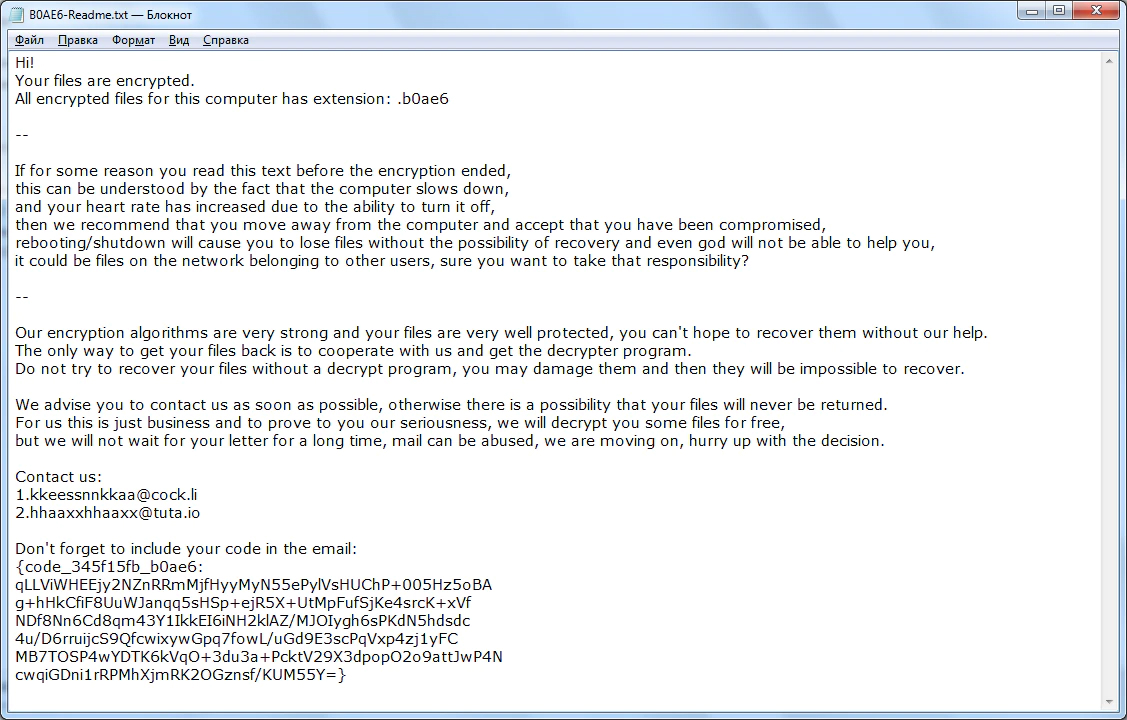
Ransom Note (Post-March 2020)
On 12 March 2020, a researcher shared a screenshot of a new NetWalker ransom note in a tweet and we can see that the attackers have changed the contact method significantly. Email communication has been dropped completely with victims now required to make contact through the NetWalker Tor interface where, after submitting their user key, they will then be redirected to a chat with NetWalker technical support. This change in contact method coincides with underground forum postings where NetWalker revealed it was opening its RaaS up for new affiliates. The Tor page was not the only noticeable change we will highlight in this blog.

NetWalker Analysis
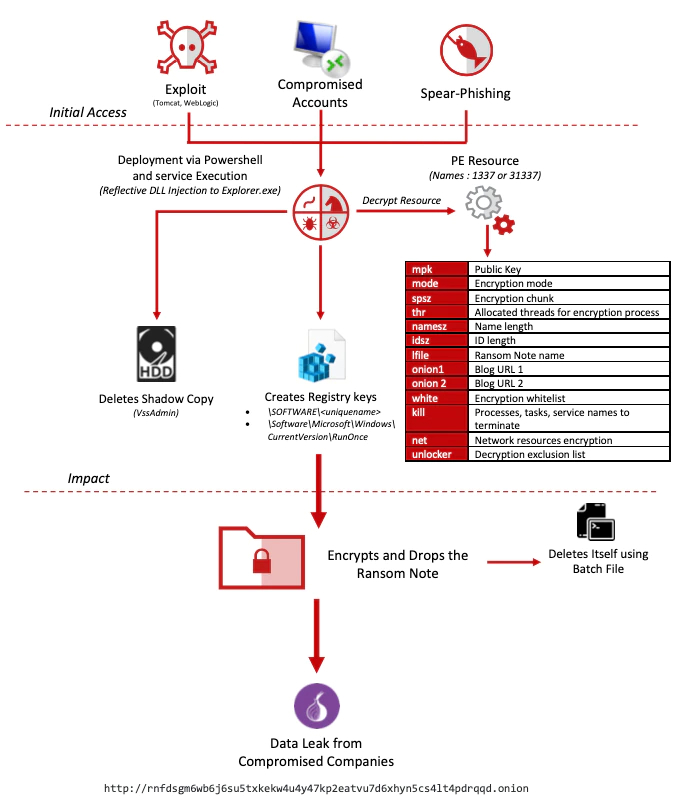
NetWalker Resource Analysis (Pre-March 2020)
The NetWalker malware uses a custom resource type (1337 or 31337) containing its entire configuration. This file is extracted to memory and decrypted using the RC4 algorithm with a hard-coded key in the resource.
Before 12 March 2020, NetWalker used the email contact process between its support operation and the victims to proceed with payment and send the decryption program. To do this, NetWalker used its configuration file in the resource to set its encryption mode, the name of the ransom note, etc., and email contacts.
| Name | wwllww.exe |
| Size | 96256 bytes |
| File-Type | EXE |
| SHA 256 | 58e923ff158fb5aecd293b7a0e0d305296110b83c6e270786edcc4fea1c8404c |
| Compile time | 6 December 2019 |
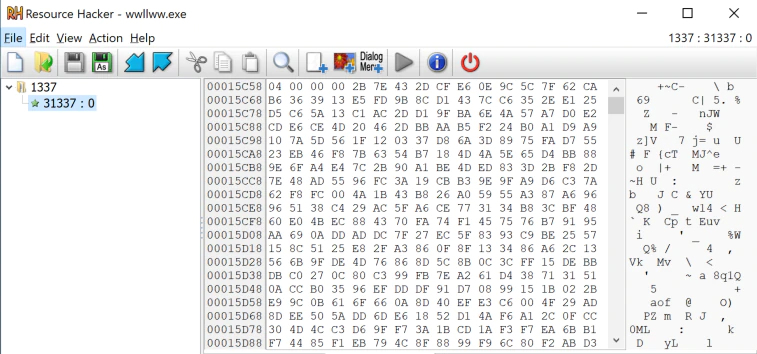
Once decrypted, the configuration file reveals several parameters, allowing us to understand how it works (how it constitutes the ransom note, the number of threads allocated for encryption, etc.):
| mpk | Public key |
| mode | Encryption mode |
| thr | Allocated threads for encryption process |
| spsz | Encryption chunk |
| namesz | Name length |
| idsz | ID length |
| crmask | .mailto[email].{ID} |
| Contact mail | |
| lfile | Ransom Note name |
| lend | B64 encoded ransom note |
| white | Encryption whitelist |
| kill | Processes, tasks, service names to terminate |
| unlocker | Decryption exclusion list |
NetWalker Resource Analysis (Post-March 2020)
When Netwalker changed its contact mode and switched from email to the submission of the user key directly on the web portal of the group’s blog, the configuration file in the resource also changed. We found changes in the configuration file, such as the disappearance of the contact “mail” and “crmask” fields (previously set as XXX@cock.li,XXX@tuta.io, etc., and .mailto[email].{ID}). This field was replaced by “onion1” and “onion2”, and these fields are set with the NetWalker blog URL/payment page (hxxp://rnfdsgm<snip>drqqd.onion/). We also noticed that the NetWalker developers complemented their “unlocker” field with some specific values (e.g. “psexec.exe, system, forti*.exe, fmon.exe*, etc”).
| Name | cnt.ex |
| Size | 70656 bytes |
| File-Type | EXE |
| SHA 256 | 26dfa8512e892dc8397c4ccbbe10efbcf85029bc2ad7b6b6fe17d26f946a01bb |
| Compile time | 2 May 2020 |

Usually, attackers use RC_DATA or a malicious BITMAP. The latter can, for example, be a regular Bitmap (open matrix image format used by Windows) that can be used by malware to execute code or as a payload dropper. The image’s pixels are an actual binary representation of the payload. This process can be summarized as Exe -> Resources -> BMP with embedded data in pixels fetched and decrypted by, e.g. a DLL -> Payload), etc. However, in this case, they use this special custom type to increase obfuscation. The NetWalker developers chose custom types by using 1337 or 31337 structs, so the resource format does not change. However, as we said, several values have changed or been replaced:
| mpk | Public Key |
| mode | Encryption mode |
| spsz | Encryption chunk |
| thr | Allocated threads for encryption process |
| namesz | Name length |
| idsz | ID length |
| lfile | Ransom Note name |
| onion1 | Blog URL 1 |
| onion 2 | Blog URL 2 |
| white | Encryption whitelist |
| kill | Processes, tasks, service names to terminate |
| net | Network resources encryption |
| unlocker | Decryption exclusion list |
| lend | B64 encoded ransom note |
NetWalker Executable Analysis (Post-March 2020)
The malware sample used for this blog post has the same information:
| Name | c21ecd18f0bbb28112240013ad42dad5c01d20927791239ada5b 61e1c6f5f010 |
| Size | 70656 bytes |
| File-Type | EXE |
| SHA 256 | c21ecd18f0bbb28112240013ad42dad5c01d20927791239ada5b 61e1c6f5f010 |
| Compile time | 2 May 2020 |
The unpacked malware is a binary file of 32 bits that can be found as an EXE file.

The malware’s first action is to combine all the required functions it needs into one large function, combining the modules already loaded in Windows with additional DLLs as described below.
Instead of searching for the function in the usual way, the malware makes a CRC32 hash of the name of each function and compares with hardcoded values. Additionally, instead of using the function “GetProcAddress”, the malware uses the Process Environment Block (PEB) to make analysis harder.
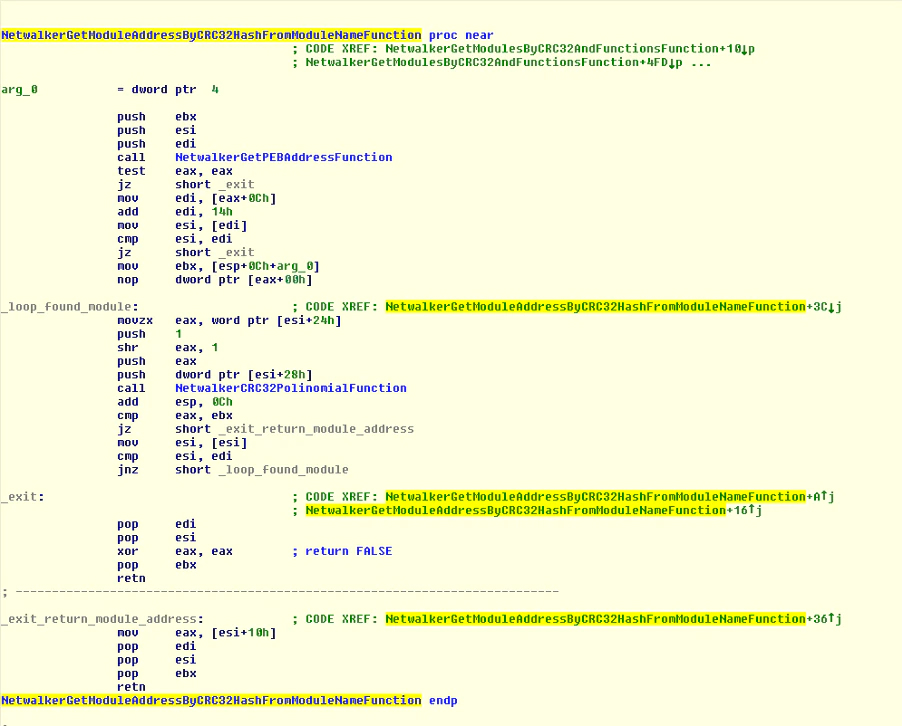
If the module cannot be discovered, it will load with “LdrLoadDll”, a native function of Windows, to try avoiding hooks in the usual functions, e.g. “LoadLibraryW”:

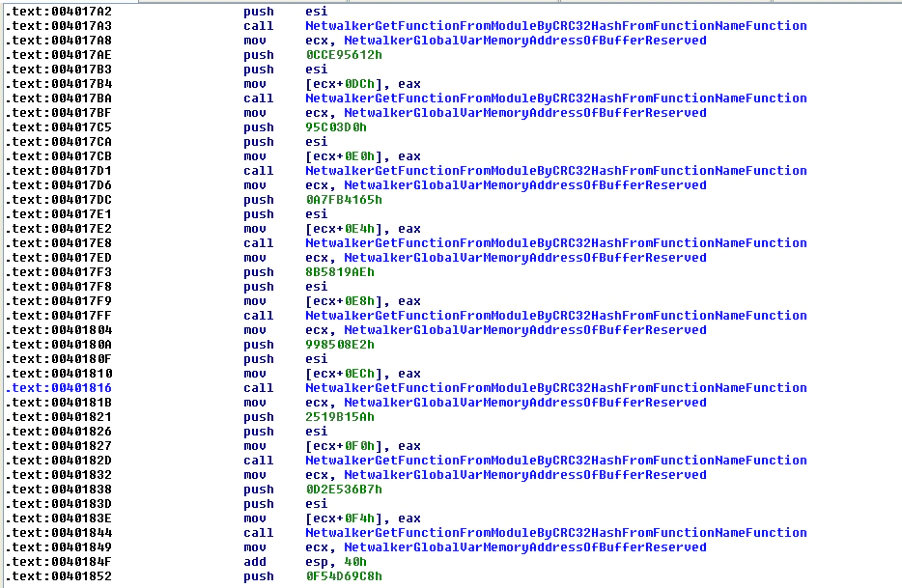
If the malware fails to get a function, it will go to a “sleep” call and terminate itself.
Later, the malware extracts the configuration file from a resource with a custom type and a custom name using the functions “FindResourceA”, “LockResource”, “LoadResource” and “SizeOfResource”. The file extracted in memory is decrypted using the RC4 algorithm with a hardcoded key in the resource.
The struct of the resource is:
- 4 bytes -> The size of the hardcoded key to decrypt the configuration file.
- Variable size -> the hardcoded key to decrypt the configuration file.
- Variable size -> the configuration file encrypted.
The malware reads the first 4 bytes and reserves memory with the size of the password and reserves memory of the resource minus 4 bytes and the size of the password. Finally, it decrypts the configuration file:

If the malware fails to get the configuration file, it will terminate itself.
After getting the configuration file, the malware will parse it and save the fields in memory and write in the registry information to encrypt the files in the machine. The malware will try first to write in the registry-hive “HKEY_LOCAL_MACHINE” but if it cannot create it, it will use the registry-hive “HKEY_CURRENT_USER”:

After the writing in the registry has been completed, it will get some privileges using a token as SE_DEBUG_PRIVILEGE and SE_IMPERSONATE_PRIVILEGE:

Later, the malware creates three threads, one to get information about the machine, such as the operating system version, one to get processes and the last one to get services in the system.
After this step, it will get the system directory and use “VSSadmin” to delete the Volume Shadow copies of the system. Volume Shadow copies can contain copies of the encrypted files and would be an option to restore from if no backup exists.

Later, the malware will enumerate the logical units, prepare the new extension for the future encrypted files, based on the size that is defined in the ransomware config with a random extension, and encrypt all files in the fixed type units and remote units with the new extension.
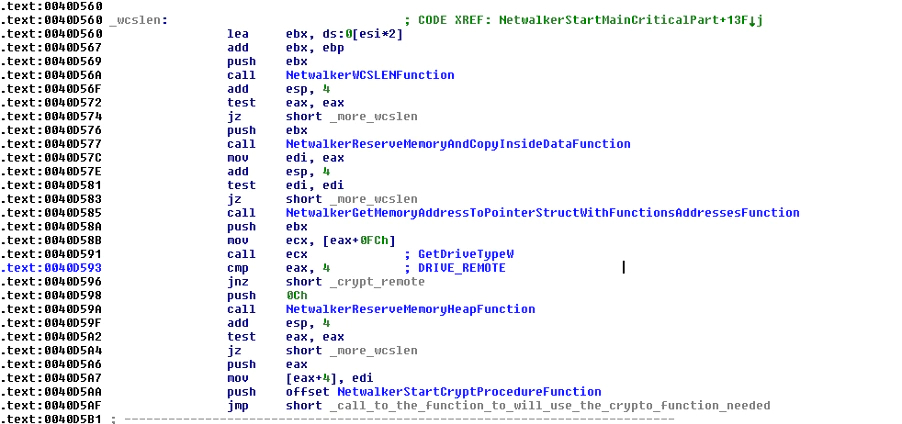
After all these steps have been completed, it will create the ransom note on the desktop using the functions “SHGetFolderPathlW” and “CreateFileW”. Subsequently, it will write the ransom note from the memory into a new file with the function “WriteFile”. The malware will create the ransom note in the root folder (for example “c:\”) of each logical unit. Next, it will launch “notepad.exe” with an argument to the ransom note file to show the user what happened on the system:
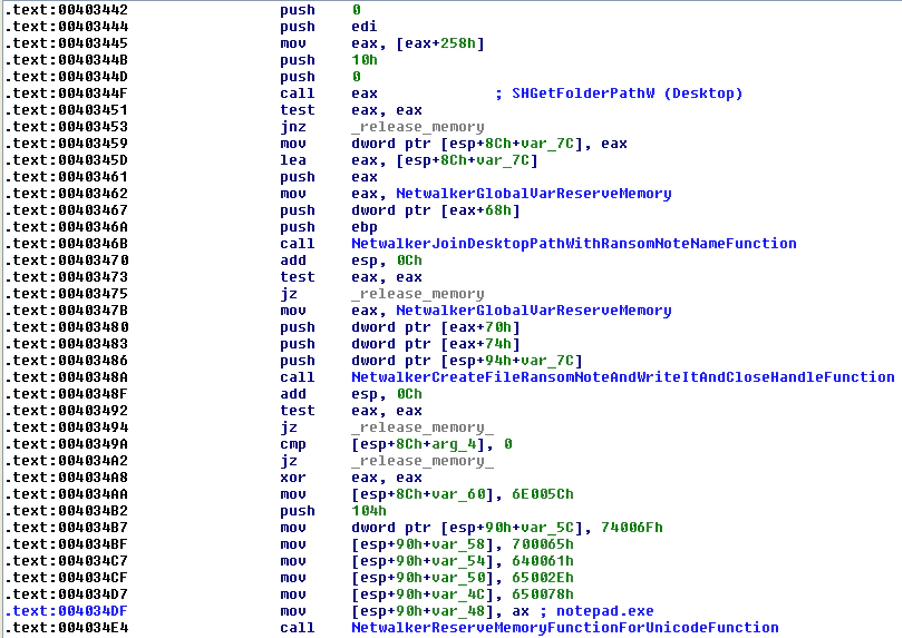
Finally, after the encryption of the files and creation of the ransom note, the malware creates a bat file in the %temp% folder of the machine with a temporary name and writes the content to destroy itself using the program “taskkill”. The batch script will delete the malware sample with its path using the command “del” and finally delete the bat file with the command “del %0%”. Of course, as the malware uses the “del” command without destroying itself before the deletion, it can be recovered with some forensic tools with luck (the same can also be said for the bat file).
This way the malware tries to remove itself from the machine to avoid being detected and analyzed by security researchers:
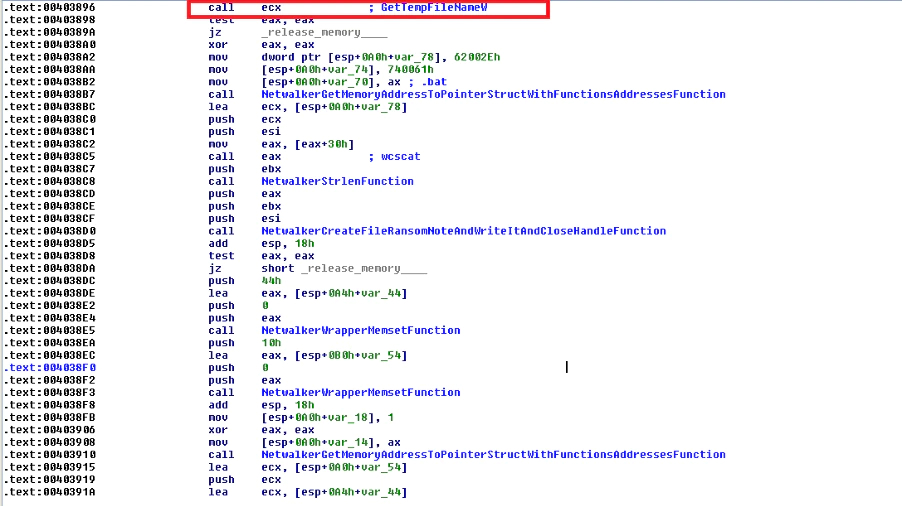
Finally, the malware will finish with “ExitProcess”.
Decryptor
When a NetWalker victim goes through technical support (see an example of this below) and pays the ransom demanded by the group they will be able to download the decryptor to clean up their environment.

The download is done directly from the NetWalker Tor site, where the payment page switches to a download page certifying that the payment was made and received:

The decryptor is delivered in a zip archive containing the decryptor executable and a note explaining how to run the program correctly:

The program launches a graphical interface allowing the user to decipher their workstation automatically or manually:
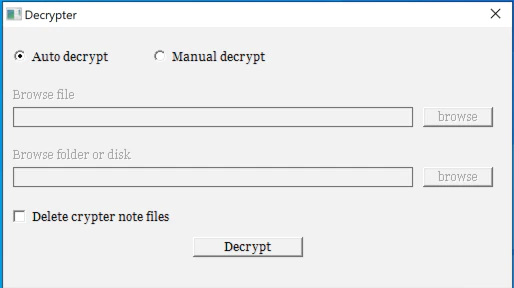
At the end of the decryption process, the program indicates the number of decrypted files, deletes the ransom note if the user has checked that option, and terminates, leaving the user to resume their work peacefully:

The decryptor program appears unique and is linked to one victim specifically. In our example, it only decrypts the files belonging to the victim who made the payment from the user key specified in the ransom note.
Underground Advertising
In March 2020, the moniker Bugatti began actively advertising the NetWalker Ransomware-as-a-Service on two popular underground fora. Bugatti seems to have joined the underground scene in February 2020 but claims to have been active with NetWalker ransomware since September 2019. We have seen NetWalker activity before March but there has been a noticeable uptick in larger victims since their advertisement. For a relatively new ransomware it has been well received and respected among other cybercriminals as compared to, for instance, Nemty ransomware. The strength of NetWalker’s reputation is such that our current hypothesis is that the individual behind Bugatti is most likely a well-respected and experienced cybercriminal, even though it is a new moniker.
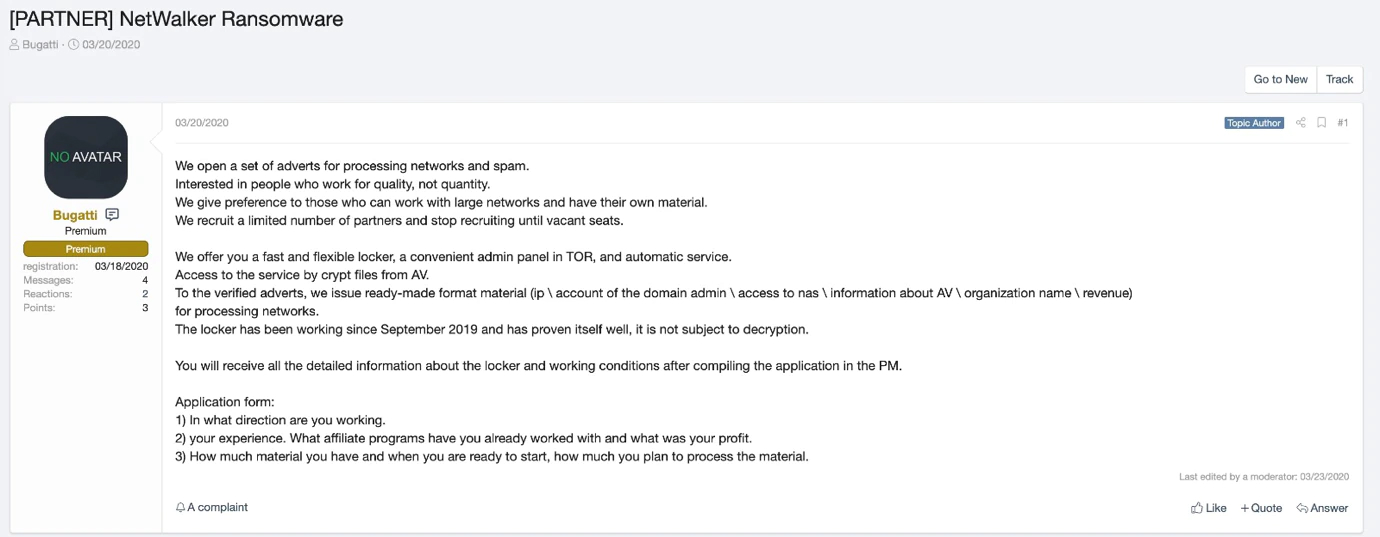
Bugatti provides regular updates on the improvements in the ransomware, such as the popular Invoke-ReflectivePEInjection method, also commonly used by Sodinokibi. In addition to the improvements in the ransomware, open slots for new affiliates are advertised. Bugatti strongly emphasized that they are primarily looking for experienced affiliates that focus on compromising the complete networks of organizations as opposed to end users. NetWalker is clearly following in the footsteps of its illustrious targeted ransomware peers like Sodinokibi, Maze and Ryuk.
One forum message in particular caught our attention as it included screenshots of several partial bitcoin addresses and USD amounts. This was most likely done to showcase the financial success of the ransomware. We have seen a similar posting in the past with the influential Sodinokibi affiliate Lalartu, so we decided to follow the money once more.

With the help of CipherTrace software we were able to find the complete BTC addresses from the screenshot and investigate the ledger further:
Screenshot 1

3JHTYZhRmMcq7WCKRzFN98vWvAZk792w9J
Screenshot 2

39aovzbz5rGoQdKjDm6JiybkSu1uGdVJ2V
Screenshot 3

39NRnZtgACDVhhmc7RwmvH9ZDUKTNwwaeB
Screenshot 4

3L4AW5kHnUCZBBjg2j1LBFCUN1RsHPLxCs
Following the Money
In the transactions mentioned in the underground forum post, the ransom amount payed by the victims is presumably shown. Since the bitcoin blockchain is a publicly accessible ledger, we can follow the money and see where the ransomware actors are transferring it to. In the case of the four posted transactions above, the full amount payed by the victim was transferred to two addresses (these addresses begin with bc1q98 and 1DgLhG respectively). It is safe to say that these two bitcoin addresses are under control of the NetWalker actors. We then proceeded on to analyze all incoming transactions to these two addresses and we were able to make the following observations:
- The first incoming transaction occurs on 1 March 2020.
- On 30 March 2020 the first incoming transaction appears where the amount is split between 4 different bitcoin addresses. A split like this is typically seen in Ransomware-as-a-Service, where the ransom payment is split between the RaaS operators and the affiliate who caused the infection. In this first transaction, the split is 80%, 10% and two 5% portions. This split matches the advertisement on the underground forum (80% – 20%).
- The two 5% portions of the ransom payments that are split, seem to be consistently transferred to the two bitcoin addresses we revealed earlier (bc1q98 and 1DgLhG).
- While the beneficiaries of the 5% cuts remain the same, the beneficiary of the 10% cut seems to change over time. Based on the forum post we assume these addresses also belong to the NetWalker actors.
- Payments to the bc1q98 and 1DgLhG addresses that are not being split continue up until the end of May. Possibly the initial NetWalker operators added a RaaS operation, while continuing to cause NetWalker infections themselves.
- While analyzing the bitcoin addresses that received 80% or more of the transaction amount, we noticed that there are some addresses that receive payments multiple times. A possible explanation could be that the address is configured as payout addresses for a certain campaign or affiliate. We identified 30 unique bitcoin addresses that seem to be the beneficiary of this larger portion of the ransom transaction. Some of these only received one payment but there are several that received multiple payments.
- In the two addresses uncovered by tracing the transactions a total of 641 bitcoin is held on 27 July 2020. Which at the current market value of bitcoin is worth well over 7 million USD.
Amounts Extorted
Working under the hypothesis that all the incoming transactions are ransomware payments; we can make the following observations:
- We found 23 transactions where the ransom payments were not split up and the beneficiaries are the two bitcoin addresses found by following the transactions mentioned in the underground forum post. The total amount of bitcoin extorted this way between 1 March 2020 and 27 July 2020 is 677 BTC. Additionally, the amount received from remaining transactions following the Ransomware-as-a-Service scheme by these addresses between 1 March 2020 and 27 July 2020 is 188 BTC.
- In the transactions that are split, the largest amount (usually 80% to 90% of the total transaction value) is presumably transferred to the affiliate that caused the infection. When we summed up these largest portions, we saw a total of 1723 BTC being transferred to affiliates.
- The total amount of extorted bitcoin that has been uncovered by tracing transactions to these NetWalker related addresses is 2795 BTC between 1 March 2020 and 27 July 2020. By using historic bitcoin to USD exchange rates, we estimate a total of 25 million USD was extorted with these NetWalker related transactions.
Even though we do not have complete visibility into the BTC flow before NetWalker started ramping up, one thing is certain, this quarter alone it has been highly successful at extorting organisations for large amounts of money. All this at a time when many sectors are struggling because people are sheltering in place and governments are trying to keep businesses from going bankrupt. NetWalker is making millions off the backs of legitimate companies.
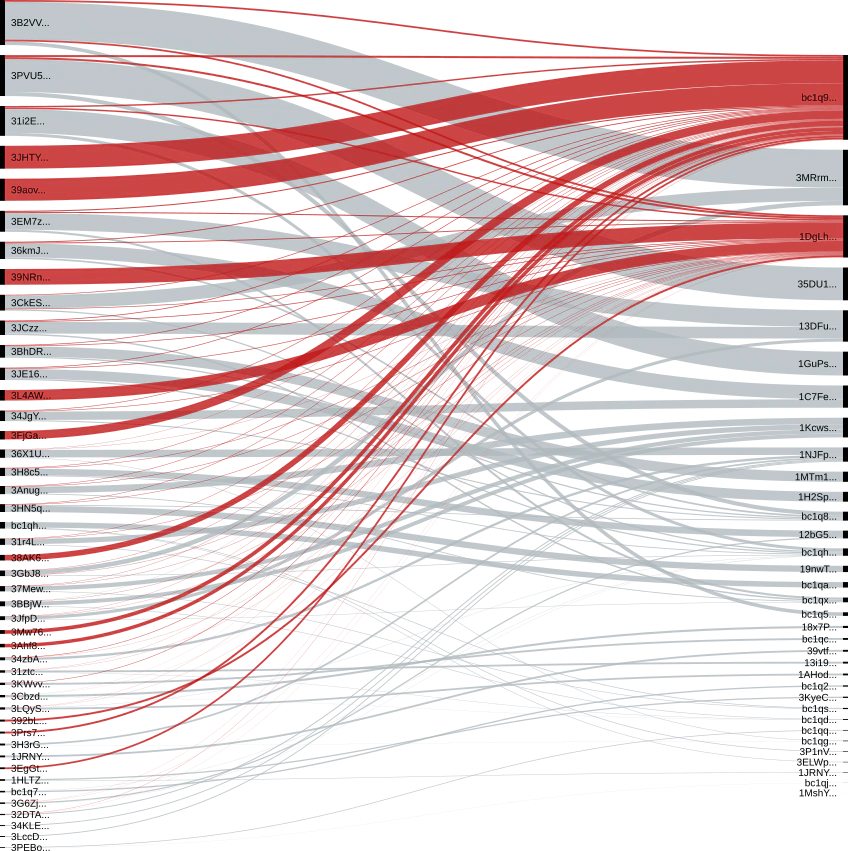
Observed Changes
While talking about the impact of NetWalker with our partners, we learned that the change in modus operandi not only affected the way the actors communicate with their victims. When there was a change from email communication to a dedicated Tor hidden service, the actors also moved away from using legacy bitcoin addresses to SegWit addresses. The benefits of using the newer SegWit addresses include faster transaction time and lower transaction cost. The NetWalker advertisement on the underground forum mentions instant and fully automatic payments around the time of this observed change. This makes us believe the ransomware actors were professionalizing their operation just before expanding to the Ransomware-as-a-Service model.
Comparison with Previous Ransomware
Given the sudden appearance of NetWalker ransomware and the associated threat actor, it suggests that some prior knowledge on ransomware development or underground presence had to be in place. Armed with this hypothesis, we searched for possible links to underground actors and other ransomware strains that might fit the bill. We came across one threat actor offering ransomware that caught our attention. It was the use of the name NetWalker, in combination with a strong ransomware connection, that sparked our interest.
Some years ago, a threat actor using the moniker Eriknetwalker was advertising ransomware on several underground forums. We found posts from 2016 and the latest public activity was around June 2019, several months before NetWalker ransomware made its appearance.
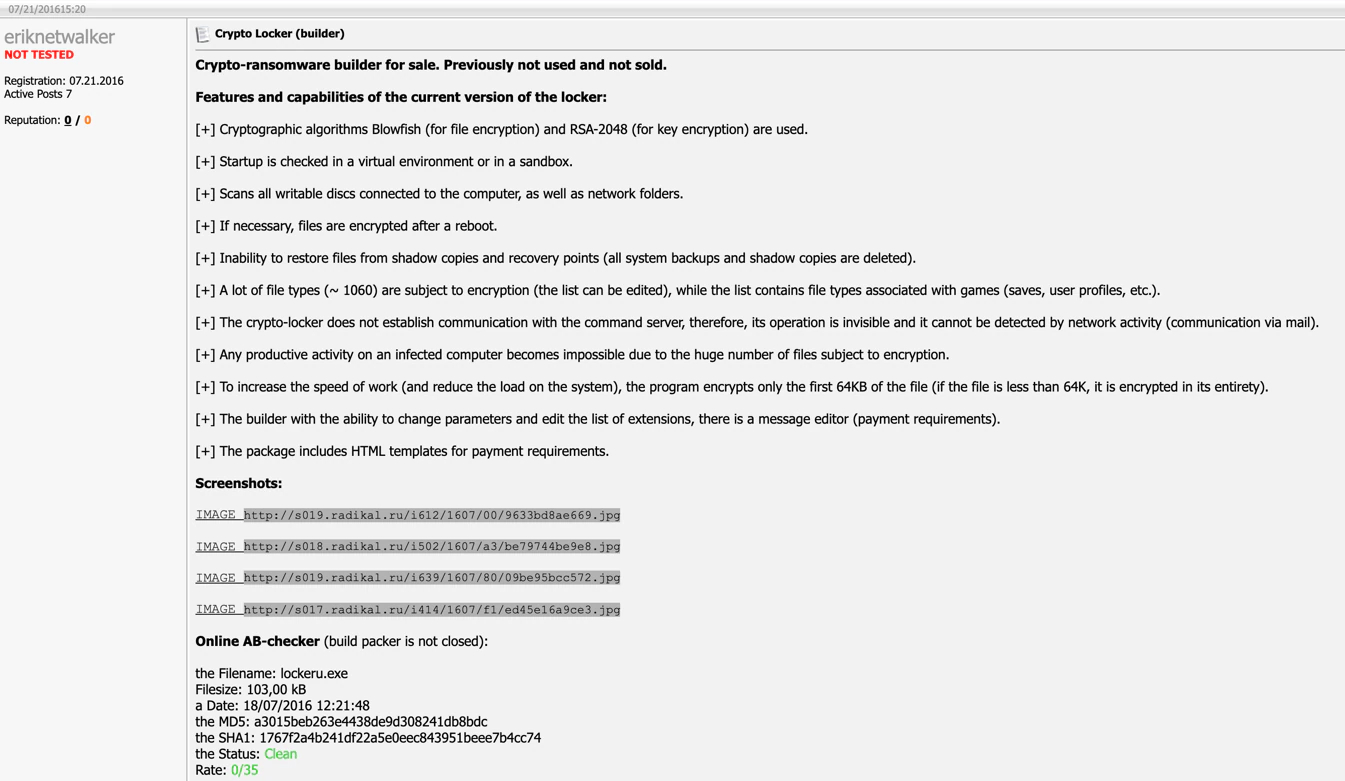
Based on our underground research, we linked the moniker Eriknetwalker to the development and/or distribution of Amnesia, Bomber and Scarab ransomware. Eriknetwalker stopped advertising ransomware around June 2019. Therefore, we decided to perform a comparative analysis between the different ransomware strains linked to Eriknetwalker and some of the earliest versions of NetWalker we could find.
The goal of this comparative analysis was to identify whether there was an overlap between source codes. Such overlap could suggest a stronger link between the current NetWalker version and the other ransomware versions from Eriknetwalker, possibly even explaining the name overlap.
To execute the analysis, we used several tools one of which was the binary visualization tool Veles, which dynamically translates binary information into an abstract visualization that allows us to identify and compare patterns.
The different types of ransomware we began analyzing were the variants of Amnesia, Scarab, and NetWalker.

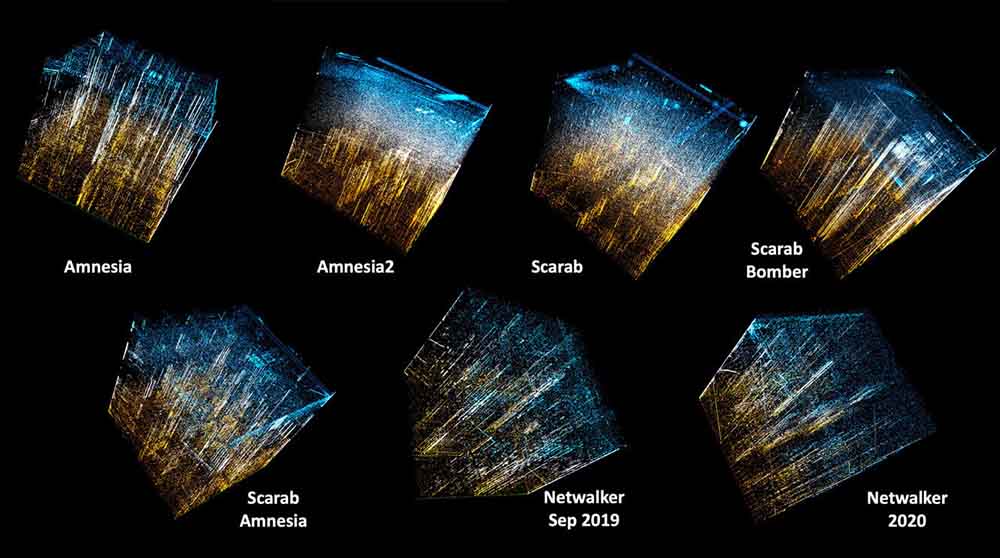
Visualizing data in such a manner is a way to use the human brain to quickly identify patterns and be able to draw comparisons between objects. In our case, we see that, based on the binary data visualized in Figures 27 and 28, the ransomware binaries do yield differences that we cannot ignore.
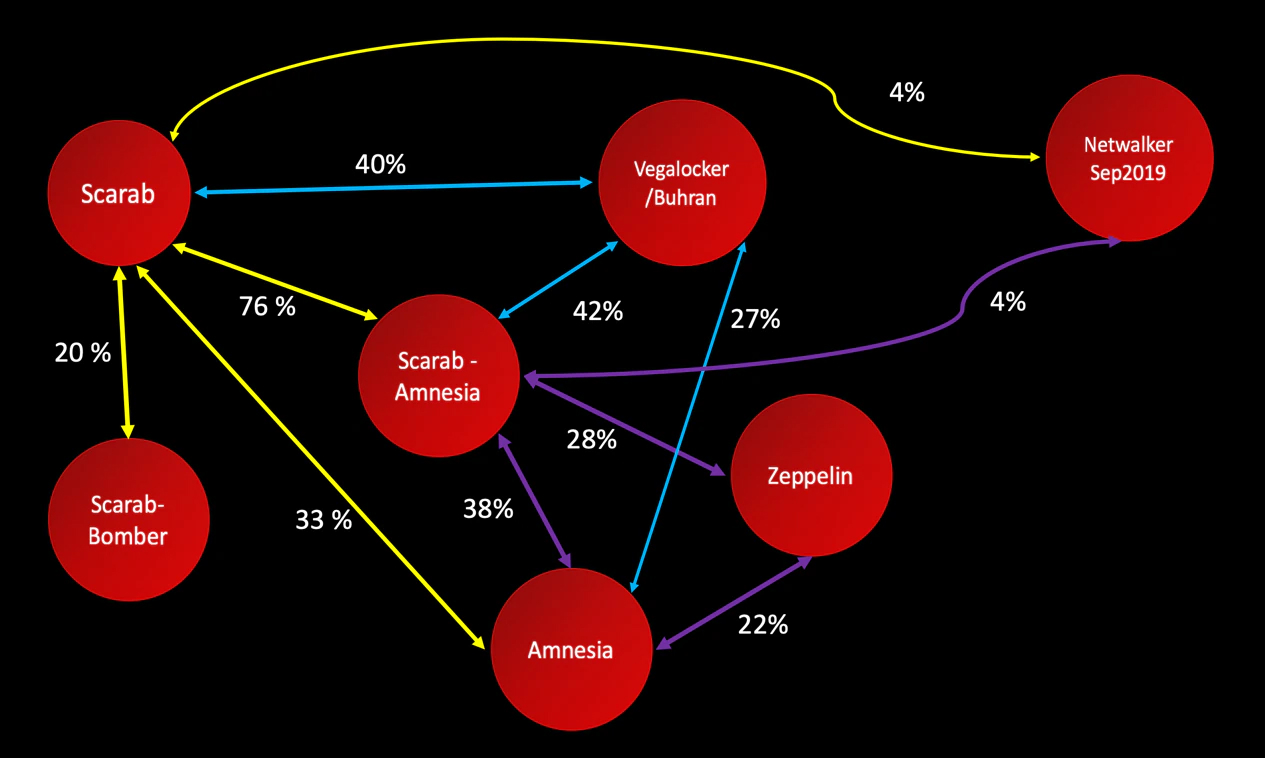
Figure 29 shows the results of a source code similarity analysis led on the different variants of ransomware named in the figure itself. Interesting enough, Scarab and Amnesia show a higher overlap with Buran and Zeppelin than the early NetWalker samples. The percentages shown are the amount of code that is similar between two variants.
As illustrated in the overview, the September 2019 NetWalker version has a different codebase from the ErikNetWalker-linked ransomware variants. This finding disproves our earlier hypothesis that NetWalker is linked to the older Amnesia variants based on code overlap.
Often, research teams do not publish their results when it disproves their own hypothesis. However, for the sake of transparency, we decided to include our research efforts.
YARA Rules
We uploaded a YARA rule to detect almost all the samples observed in the wild to date.
Indicators of Compromise
During our investigation we have observed numerous IoCs linked to NetWalker ransomware. To obtain them please visit our McAfee ATR GitHub site, or get the latest NetWalker IoCs and intelligence on many other threats with MVISION Insights.
MITRE ATT&CK Techniques
The below techniques were based on our research and complemented with research from industry peers.
- Initial Access
- Exploit Public-Facing Application (T1190) : Exploit Tomcat, Exploit WebLogic
- Spear phishing Attachment (T1566.001): Phishing email
- Valid Accounts (T1078): RDP compromised
- Execution
- PowerShell (T1059.001): PowerShell Script
- Command and Scripting Interpreter: Windows Command Shell (003)
- Service Execution (T1569.002): PsExec
- Native API (T1106): Use Windows API functions to inject DLL
- Windows Management Instrumentation (T1047)
- Persistence
- Registry Run Key (T1547.001): Place a value on RunOnce key
- Modify Registry key (T1112): Create its own registry key in \SOFTWARE\<uniquename>
- Privilege Escalation
- Exploitation for Privilege Escalation (T1068): CVE-2020-0796, CVE-2019-1458, CVE-2017-0213, CVE-2015-1701
- Process Injection (T1055.001): Reflective DLL Injection
- Defense Evasion
- Disabling Security Tools (T1562.001): ESET AV Remover, Trend Micro’s Security Agent Uninstall Tool, Microsoft Security Client Uninstall
- Process Injection (T1055.001): Reflective DLL Injection
- Deobfuscate/Decode Files or Information (T1140)
- Obfuscated Files or Information (T1027): PowerShell Script uses Base64 and hexadecimal encoding and XOR-encryption
- Credential Access
- Credential Dumping (T1003): Mimikatz, Mimidogz, Mimikittenz, Windows Credentials Editor, Pwdump, LaZagne
- Brute Force (T1110.001): NLBrute
- Discovery
- Network Service Scanning (T1046): SoftPerfect Network Scanner
- Security Software Discovery (T1518.001)
- System Information Discovery (T1082)
- Lateral Movement
- Third-Party Software (T1072): TeamViewer, Anydesk
- Service Execution (T 1569.002): PsExec
- Lateral Tool Transfer (T1570)
- Collection
- Data from information repositories (T1213)
- Data from local system (T1005)
- Data from network shared drive (T1039)
- Command and Control
- Ingress Tool Transfer (T1105)
- Impact
- Data Encrypted (T1486): NetWalker Ransomware
- Inhibit System Recovery (T1490): Shadow Copies Deleted
- Service Stop (T1489)

Conclusion
Ransomware has evolved into a lucrative business for threat actors, from underground forums selling ransomware, to offering services such as support portals to guide victims through acquiring crypto currency for payment, to the negotiation of the ransom. McAfee’s Advanced Threat Research team has analysed the NetWalker ransomware and have been following its evolution from the initial sighting of the Mailto ransomware to its redevelopment into the NetWalker ransomware. The recent shift to a business-centric model of Ransomware-as-a-Service is a clear sign that it is stepping up, so it seems that the NetWalker group is following in the footsteps of REvil and other successful RaaS groups. The ransomware developers have proven the ability to refocus and capitalize on current world events and develop lures to help ensure the effectiveness of the ransomware, which has allowed them to become selective of their affiliates by limiting access to the ransomware to only those with vetted access to large organizations. As development of the ransomware continues, we have witnessed recent shifts in activity that closely follow in the footsteps of other ransomware developments, including threatening victims with the release of confidential information if the ransom is not met.
McAfee ATR is actively monitoring ransomware threats and will continue to update McAfee MVISION Insights and its social networking channels with new and current information. MVISION Insights is the only proactive endpoint security solution that simultaneously prioritizes and predicts threats that matter to our customers while offering prescriptive guidance on what to do in their local environment. Want to stay ahead of the adversaries? Check out McAfee Insights for more information. If you want to experience some of the MVISION Insights capabilities, go the Preview of MVISION Insights where you can select the top threat information that is available.
Authored by: Thibault Seret, Valentine Mairet, Jeffrey Sman, Alfred Alvarado, Tim Hux, Alexandre Mundo, John Fokker, Marc Rivero Lopez and Thomas Roccia.
RECENT NEWS
-
Jun 17, 2025
Trellix Accelerates Organizational Cyber Resilience with Deepened AWS Integrations
-
Jun 10, 2025
Trellix Finds Threat Intelligence Gap Calls for Proactive Cybersecurity Strategy Implementation
-
May 12, 2025
CRN Recognizes Trellix Partner Program with 2025 Women of the Channel List
-
Apr 29, 2025
Trellix Details Surge in Cyber Activity Targeting United States, Telecom
-
Apr 29, 2025
Trellix Advances Intelligent Data Security to Combat Insider Threats and Enable Compliance
RECENT STORIES
Featured Content
Get the latest
Stay up to date with the latest cybersecurity trends, best practices, security vulnerabilities, and so much more.
Zero spam. Unsubscribe at any time.